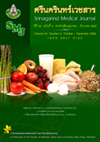Food Consumption Behavior and Nutritional Status of Atherosclerotic Heart Disease Patient in Outpatient Department, Queen Sirikit Heart Center of the Northeast, Thailand.
Abstract
Background and Objective: Atherosclerotic heart disease is not a curable disorder. But properly behavior changing food consumption can control disease. The researchers are interested in investigating food consumption behavior and nutritional status of the atherosclerotic heart disease patients in order to gain basic information for changing or promoting proper food consumption behavior to control disease.
Methods: This descriptive study in seventy-nine atherosclerotic heart disease patients who lived in Khon Kaen province and attended the Outpatient Department of Queen Sirikit Heart Center were included in the study. Research instruments were questionnaires and nutritional status assessment form descriptive statistics. The results were presented as percent, pregnancy and mean. The association between defined factors and nutritional status was determined by Pearson’s chi-square test and fisher’s exact test.
Results: Fifty nine point five percent of the atherosclerotic heart disease patients were male with age-range between 61-70 years old. (S.D.=11.0), The quantity of 44.3% had good knowledge whereas 32.9 had fair knowledge. 63.3% had good attitude. Regarding food consumption frequencies, 63.3%, 53.2% and 25.3% consumed fish, vegetable and steaming dishes daily. There was different food consumption comparing before and after being diagnosed. After diagnosis, patients consumed more vegetables and fish as well as avoiding high fat dish. According to patient’s self assessment report, 27.8% still reported problem on diet control and 60.7% had body mass index as over-nutrition (BMI>22.9). The percentages of 60.7% and 79.7% had waist circumferences and waist-hip ratio greater than normal. To investigate factors associated with over-nutrition in atherosclerotic heart disease patients, it was found that exercise and waist circumference were associated with atherosclerosis heart disease patietns’over-nutrition statiscally significant at p-value <0.05.
Conclusion: The atherosclerotic heart disease patients’ knowledge were rated as good and fair. The patients were improving their consumption behavior after the diagnosis but there were some overnutrition patients with improper food habits, so additional knowledge should be provided in order to change their habits which will be good for their health status.
Key words: Knowledge, Attitude, Food consumption, Nutritional status, Atherosclerotic heart disease patient




